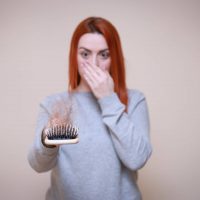Shedding is Normal When Cold Capping
Published: May 30, 2023
For many cancer patients, one of the most distressing aspects of chemotherapy is the prospect of losing their hair. However, cold cap therapy, also known as scalp cooling, can help minimize hair loss during chemotherapy.
What many people don’t anticipate when cold capping is that it’s more than likely you will experience hair shedding. When their hair starts to shed, they instantly jump to the conclusion that it’s not working and can become disheartened. But it’s important to understand that shedding is a completely normal part of the cold capping process.
At Penguin Cold Caps, the original cold cap therapy company, we understand how challenging hair loss can be during chemotherapy. This article looks at the shedding process and how to cope with it:

Shedding Happens to Everyone
At some level, anyone who chooses to cold cap needs to expect some shedding. For most people, shedding will start between 14 and 21 days after their first treatment, as the chemo’s effect on the follicles begins to show. While cold capping protects your follicles and minimizes hair loss, it cannot save every hair. However, shedding does not mean cold capping isn’t working for you.
Shedding Isn’t the Same for Everyone
Shedding is different for everyone, even those on the same regimen. If you have thick hair, you may experience more shedding than someone with thinner hair – simply because you have more hair in the first place. There can also be big differences in the amount you shed depending on what drug regimen you’re on. You’ll find a list of just some of the chemo drugs patients have saved their hair with Penguin Cold Caps on the link below.
Check your drug regimen will work with Penguin Cold Caps
This list is not extensive, so if you’ve been prescribed something different, please get in touch with our customer service team to find out past success rates for your specific plan.
Shedding is Normal
It’s important to remember that shedding is an expected part of cold capping. Even people who have achieved the best results will have experienced shedding along the way. Shedding doesn’t happen just because you didn’t follow the rules; in most instances, there’s nothing you could have done to stop it. To get the very best results, you need to ensure the caps are cooled to the correct temperature before you put them on, they’re fitted and secured snugly to your head, and you stick to your rep’s instructions with regards to timings, which includes wearing them before, during and for several hours after your chemo session has ended.
You also need to follow your Penguin rep’s hair care routine as closely as possible; for more on this, see our blog on Hair Management when cold capping.
Coping with Shedding
Shedding can be tough emotionally, and everyone copes with it differently. You’ll likely notice it most in the shower or when you comb your hair, and you may find it helpful to compare the amount you lose daily. Wearing a sleep cap at night or even a hair net at home can help avoid inadvertently tugging on weakened hair follicles. But if you’re struggling, talk to your Penguin rep. They’re there to reassure you that everything’s normal and offer advice whenever you need it.
Shedding and Regrowth
Shedding and regrowth can happen simultaneously. While shedding can be challenging to cope with, it’s important to remember that regrowth will also occur. Cold cap therapy can help to preserve hair follicles, allowing for faster regrowth after chemotherapy.
It’s important to remember that normal shedding will still occur during scalp cooling. Everyone loses around 100 strands daily due to the normal, healthy hair growth cycle, which will continue during scalp cooling. It can be hard to remember what normal shedding looks and feels like after chemotherapy, but remember that some daily shedding is completely normal for everyone.
Post-Treatment Shedding is Normal
Shedding won’t stop just because your chemo treatment has finished, and you should expect to shed for 8 to 12 weeks afterward. If shedding persists beyond this, it may be worth speaking to your doctor, as other factors can affect hair retention, including low hemoglobin levels and anemia.
In conclusion, everyone who has cold capped should expect their hair to shed. And while it can be upsetting, it’s important to remember that shedding does not mean that therapy isn’t working, and even those with the best outcomes will experience shedding.
What support when capping with Penguin Cold Caps
At Penguin Cold Caps, we understand how challenging hair loss can be during chemotherapy. We are committed to helping you preserve your hair and retain a sense of self during this difficult time. Many of our reps are former cancer patients who have successfully saved their hair with Penguin Cold Caps. As a result, they have all experienced shedding. They will understand exactly how you feel and know what support you need.
They’ve also helped numerous patients with cold caps and seen how different drugs and hair types respond to cold cap therapy. They are there for you if you need reassurance or advice on shedding or any other questions about cold capping.
If you are thinking about cold capping and what to know more, request a call-back, and we’ll be in touch.
If you have any questions about cold capping, or anything else related to your chemo treatment, why not join the Facebook Chemotherapy Support Group – with thousands of members reaching out to each other, someone will no doubt be able to offer you first hand advice.